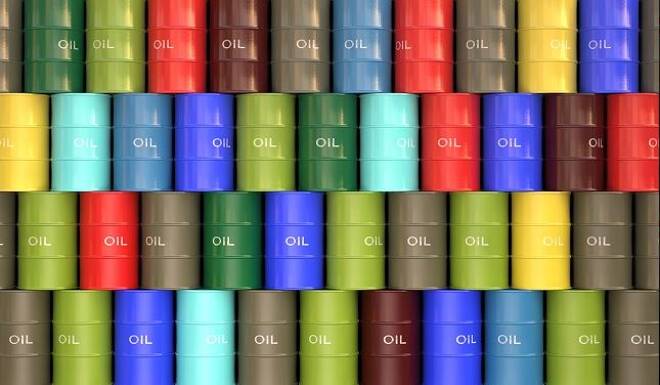Advertisement
Advertisement
Crude Oil Price Analysis for November 22, 2017
By:
OPECs decision on output cuts is keeping the markets in limbo, and with Russia the wildcard this weekend, trader’s will likely keep their powder dry.
OPECs decision on output cuts is keeping the markets in limbo, and with Russia the wildcard this weekend, trader’s will likely keep their powder dry. Despite the focus on OPEC, traders still need to focus on Tuesday’s API inventory numbers that will be followed by the EIA inventory numbers which are scheduled for Wednesday.
Technicals
Crude oil prices rose 1.35% on Tuesday but settled off the session highs. Prices tested short term support near the 10-day moving average near 56.31. Resistance is seen near the November highs at 57.92. Negative momentum has decelerated as the MACD (moving average convergence divergence) histogram prints in the red with a flattening trajectory which points to consolidation. The relative strength index, is moving sides but higher, which portrays a grinding slow uptrend.
OPEC Meeting is Critical
The November 30 meeting in Vienna of OPEC and its partners in the oil production will be critical and if anyone in the group balks, prices will get hammered. Russia, the world’s top producer and exporter, who agreed to a relatively minor production cut from its nearly record-high rate of production, could be the member that generates volatility.
Reports emerged last week that Russia is considering a delay on the decision to extend the cut. That’s after Energy Minister Alexander Novak hinted more than once that from Moscow’s perspective, this decision is far from urgent. With a budget based on Brent at US$40, Russia is indeed in a sweet spot compared with its partners in the deal.
But there may be another reason for Moscow deciding to opt out of the extension. Lower oil prices could actually be more beneficial for the Russian economy. For starters, the higher the price of oil, the greater the risk of another collapse down the road. The more oil costs, the more producers will invest in new production, possibly leading to a repeat of the 2014 collapse. Or prices could simply take a dive once the OPEC deal ends, which it must at some point.
A higher oil price would also likely compromise a budget reform currently in the works, which aims to rein in spending. More importantly, Russia’s economic diversification efforts may well be compromised if oil prices remain higher.
Yet another reason is that Moscow prefers to keep the ruble cheaper as this stimulates exports, curbs imports, and boosts competitiveness. Traditionally, the Russian currency has followed Brent’s moves closely, but this link has now been severed thanks to a fiscal rule mechanism employed by the Russian Finance Ministry that involves converting more rubles into forex as tax on the oil industry rises, pressuring the local currency. If, however, Brent goes high enough, there may be a spike in speculative interest in rubles, which will cause the currency to rise, too.
These reasons make perfect sense for Russia. They are unlikely to be praised by its partners in the deal, however. Right now, according to analysts, OPEC’s meeting on November 30 and the deal extension expected to result from it is the single most important tailwind for oil prices.
Canada Maintains AAA Rating
Canada’s AAA credit rating affirmed by S&P on long term sovereign credit, while the ratings agency also bestowed its A-1+ rating on short term sovereign credit. S&P cites strong institutional effectiveness, high quality human capital and substantial fiscal and monetary buffers. They acknowledge the risk posed to the GDP outlook by rising U.S. protectionism. but say the economy’s wealth and resilience will allow it to adapt to a variety of “realistic scenarios” of NAFTA negotiations. There was some concern early this year that Canada was at risk of loosing its status as one of the few nations with a AAA credit rating, as outlooks rapidly adjusted to the Trump administrations aggressive tone on trade. But a strong first half of GDP growth and a more sober view of Canada’s ability to adjust to realistic trade scenarios justifies a top credit rating for Canada.
Canada Wholesale Shipments Fell
Canada wholesale shipment values fell 1.2% in September after a revised 0.4% gain in August (was +0.5%). The decline was contrary to expectations. Sales were weaker in five of seven subsectors. Personal and household goods led the way with a 4.8% plunge, marking the first drop since November of 2016. Total wholesale shipment volumes declined 1.1% in September, which is bad news for the September GDP outlook
About the Author
David Beckerauthor
David Becker focuses his attention on various consulting and portfolio management activities at Fortuity LLC, where he currently provides oversight for a multimillion-dollar portfolio consisting of commodities, debt, equities, real estate, and more.
Did you find this article useful?
Latest news and analysis
Advertisement
